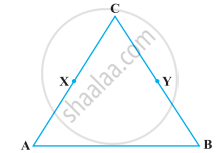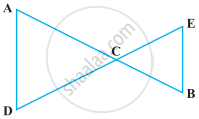Advertisements
Advertisements
Question
If a point C lies between two points A and B such that AC = BC, point C is called a mid-point of line segment AB. Prove that every line segment has one and only one mid-point.
Solution
Let there be two mid-points, C and D.

C is the mid-point of AB.
AC = CB
AC + AC = BC + AC ...(Equals are added on both sides) …(1)
Here, (BC + AC) coincides with AB. It is known that things which coincide with one another are equal to one another.
∴ BC + AC = AB …(2)
It is also known that things which are equal to the same thing are equal to one another. Therefore, from equations (1) and (2), we obtain
AC + AC = AB
⇒ 2AC = AB …(3)
Similarly, by taking D as the mid-point of AB, it can be proved that
2AD = AB …(4)
From equation (3) and (4), we obtain
2AC = 2AD ...(Things which are equal to the same thing are equal to one another.)
⇒ AC = AD ...(Things which are double of the same things are equal to one another.)
This is possible only when point C and D are representing a single point.
Hence, our assumption is wrong, and there can be only one mid-point for a given line segment.
APPEARS IN
RELATED QUESTIONS
The following statement is true or false? Give reason for your answer.
Only one line can pass through a single point.
Give a definition of the following term. Are there other terms that need to be defined first? What are they, and how might you define them?
parallel lines
Why is Axiom 5, in the list of Euclid’s axioms, considered a ‘universal truth’? (Note that the question is not about the fifth postulate.)
How many planes can be made to pass through three distinct points?
Euclid divided his famous treatise “The Elements” into ______.
Boundaries of surfaces are ______.
Solve the following question using appropriate Euclid’s axiom:
In the following figure, we have X and Y are the mid-points of AC and BC and AX = CY. Show that AC = BC.

Solve the following question using appropriate Euclid’s axiom:
In the following figure, we have ∠1 = ∠2, ∠2 = ∠3. Show that ∠1 = ∠3.

Solve the following question using appropriate Euclid’s axiom:
In the following figure, we have AC = DC, CB = CE. Show that AB = DE.

Read the following statements which are taken as axioms:
- If a transversal intersects two parallel lines, then corresponding angles are not necessarily equal.
- If a transversal intersect two parallel lines, then alternate interior angles are equal.
Is this system of axioms consistent? Justify your answer.
